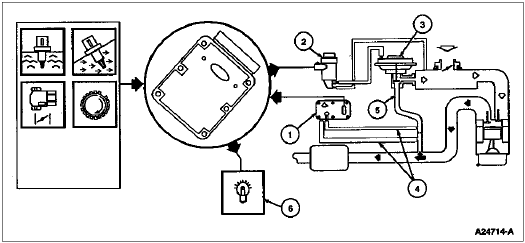Home
| Mailing
List | Specifications | Care
and Feeding | Modifications | Vendors
| Literature

Title - Exhaust Gas Recirculation (EGR) System Monitor
10/8/2003
The solenoid is opened which allows vacuum to then flow to
the regulator that then goes to the EGR valve. This then through intake
vacuum draws in exhaust gas whose flow is measured by the Differential
Pressure Feedback sensor which generates a reference voltage based on exhaust
gas flow.
From Helm...
"Exhaust Gas Recirculation (EGR) System Monitor— Differential
Pressure Feedback EGR
The Differential Pressure Feedback EGR System Monitor is an on-board
strategy designed to test the integrity and flow characteristics of the EGR
system. The monitor is activated during EGR system operation and after certain
base engine conditions are satisfied. Input from the ECT, IAT, TP and CKP
sensors is required to activate the EGR System Monitor. Once activated, the
EGR System Monitor will perform each of the tests described below during the
engine modes and conditions indicated. Some of the EGR System Monitor tests
are also performed during on demand self-test.
- The Differential Pressure Feedback EGR sensor and circuit are
continuously tested for opens and shorts. The monitor looks for the
Differential Pressure Feedback EGR circuit voltage to exceed the maximum
or minimum allowable limits.
The DTCs associated with this test are DTCs P1400 and P1401.
- The EGR Vacuum Regulator solenoid is continuously tested for opens and
shorts. The monitor looks for an EGR Vacuum Regulator circuit voltage that
is inconsistent with the EGR Vacuum Regulator circuit commanded output
state.
The DTC associated with this test is DTC P1409.
- The test for a stuck open EGR valve or EGR flow at idle is continuously
performed whenever at idle (TP sensor indicating closed throttle). The
monitor compares the Differential Pressure Feedback EGR circuit voltage at
idle to the Differential Pressure Feedback EGR circuit voltage stored
during key on engine off to determine if EGR flow is present at idle.
The DTC associated with this test is DTC P0402.
- The Differential Pressure Feedback EGR sensor upstream hose is tested
once per drive cycle for disconnect and plugging. The test is performed
with EGR valve closed and during a period of acceleration. The PCM will
momentarily command the EGR valve closed. The monitor looks for the
Differential Pressure Feedback EGR sensor voltage to be inconsistent for a
no flow voltage. A voltage increase or decrease during acceleration while
the EGR valve is closed may indicate a fault with the signal hose during
this test.
The DTC associated with this test is DTC P1405.
- The EGR flow rate test is performed during a steady state when engine
speed and load are moderate and EGR Vacuum Regulator duty cycle is high.
The monitor compares the actual Differential Pressure Feedback EGR circuit
voltage to a desired EGR flow voltage for that state to determine if EGR
flow rate is acceptable or insufficient. This is a system type test and
may trigger a DTC for any fault causing the EGR system to fail.
The DTC associated with this test is DTC P0401.
- DTC P1408 is similar to P0401 but performed during KOER Self-Test
conditions.
- The MIL is activated after one of the above tests fail on two
consecutive drive cycles.

Figure 15: EGR System Monitor - Differential Pressure Feedback EGR"
Our thanks once again to our fast friend for his exhaustive, ok bad joke, research.
This information is protected by copyright From Ford. I
didn't ask permission.
Larry
Contact Information


